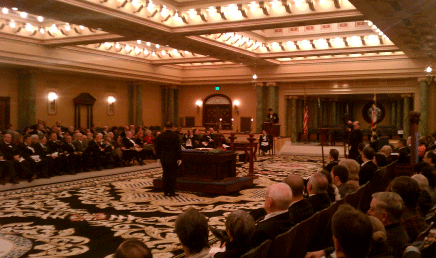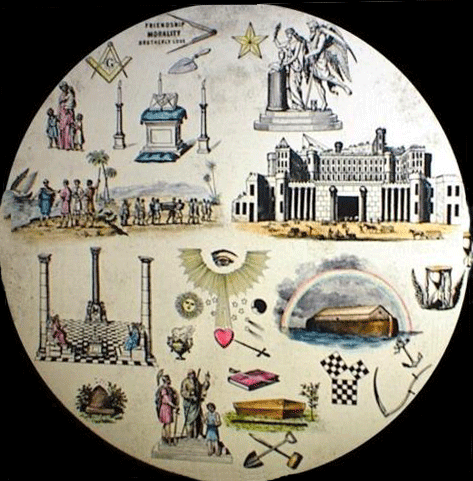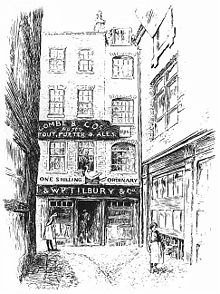What Is Masonry?
Freemasonry is a fraternal organisation that traces its origins to the local fraternities of stonemasons, which from the end of the fourteenth century regulated the qualifications of masons and their interaction with authorities and clients. The degrees of freemasonry, its gradal system, retain the three grades of medieval craft guilds, those of Apprentice, journeyman or Fellow (now called Fellowcraft), and Master Mason. These are the degrees offered by craft, or blue lodge Freemasonry. There are additional degrees, which vary with locality and jurisdiction, and are now administered by different bodies than the craft degrees.

Grand Lodge of Maryland
The basic, local organizational unit of Freemasonry is the lodge. The lodges are usually supervised and governed at the regional level (usually coterminous with either a state, province, or national border) by a Grand Lodge or Grand Orient. There is no international, world-wide Grand Lodge that supervises all of Freemasonry. Each Grand Lodge is independent, and they do not necessarily recognise each other as being legitimate.
The Masonic Lodge is the basic organisational unit of Freemasonry. The lodge meets regularly to conduct the usual formal business of any small organisation (pay bills, organize social and charitable events, elect new members, etc.). In addition to business, the meeting may perform a ceremony to confer a Masonic degree or receive a lecture, which is usually on some aspect of Masonic history or ritual. At the conclusion of the meeting, the lodge might adjourn for a formal dinner, or festive board, sometimes involving toasting and song.
Masonic Ritual consists of degree ceremonies. Candidates for Freemasonry are progressively initiated into Freemasonry, first in the degree of Entered Apprentice. Some time later, in a separate ceremony, they will be passed to the degree of Fellowcraft, and finally they will be raised to the degree of Master Mason. In all of these ceremonies, the candidate is entrusted with passwords, signs and grips peculiar to his new rank. Another ceremony is the annual installation of the Master and officers of the lodge. In some jurisdictions Installed Master is valued as a separate rank, with its own secrets to distinguish its members. In other jurisdictions, the grade is not recognized, and no inner ceremony conveys new secrets during the installation of a new Master of the lodge.
Most lodges have some sort of social calendar, allowing Masons and their partners to meet in a less ritualized environment. Often coupled with these events is the obligation placed on every Mason to contribute to charity. This occurs at both lodge and Grand Lodge level. Masonic charities contribute to many fields from education to disaster relief.
These private local lodges form the backbone of Freemasonry, and a Freemason will necessarily have been initiated into one of these. There also exist specialist lodges where Masons meet to celebrate anything from sport to Masonic research. The rank of Master Mason also entitles a Freemason to explore Masonry further through other degrees, administered separately from the craft, or "blue lodge" degrees described here, but having a similar format to their meetings.
Because each Masonic Jurisdiction is independent, each sets its own procedures. Thus the wording of the ritual, the number of officers present, the layout of the meeting room, etc. varies from jurisdiction to jurisdiction. However, the basic emphasis of each degree is relatively consistent.
The officers of the lodge are elected or appointed annually. Every Masonic Lodge has a Master, two Wardens, a secretary and a treasurer. There is also a Tyler, or outer guard, who is always present outside the door of a working lodge. Other offices vary between jurisdictions.
Ritual and Symbolism
Freemasonry describes itself as a "beautiful system of morality, veiled in allegory and illustrated by symbols". The symbolism is mainly, but not exclusively, drawn from the manual tools of stonemasons - the square and compasses, the level and plumb rule, the trowel, among others. A moral lesson is attached to each of these tools, although the assignment is by no means consistent. The meaning of the symbolism is taught and explored through ritual.
All Freemasons begin their journey in the "craft" by being progressively initiated, passed and raised into the three degrees of craft, or blue lodge Masonry. During these three rituals, the candidate is progressively taught the meanings of the lodge symbols, and entrusted with grips, signs and words to signify to other Masons that he has been so initiated. The initiations are part allegory and part lecture, and revolve around the construction of the Temple of Solomon, and the artistry and death of his chief architect, Hiram Abiff. The degrees are those of Entered apprentice, Fellowcraft and Master Mason. While many different versions of these rituals exist, with two different lodge layouts and versions of the Hiram myth, each version is recognisable to any Freemason from any jurisdiction.
In some jurisdictions the main themes of each degree are illustrated by tracing boards .

The Master's Carpet
The idea of Masonic brotherhood probably descends from a 16th-century legal definition of a brother as one who has taken an oath of mutual support to another. Accordingly, Masons swear at each degree to keep the contents of that degree secret, and to support and protect their brethren unless they have broken the law. In most lodges the oath or obligation is taken on a Volume of Sacred Law, whichever book of divine revelation is appropriate to the religious beliefs of the individual brother (usually the Holy Bible, Holy Kur'an, or Bhagavad-Gita).
History and Origins

Goose and Gridiron, where the Grand Lodge of England was founded
Since the middle of the 19th century, Masonic historians have sought the origins of the movement in a series of similar documents known as the Old Charges, dating from the Regius Poem in about 1425 to the beginning of the 18th century. Alluding to the membership of a lodge of operative masons, they relate a mythologised history of the craft, the duties of its grades, and the manner in which oaths of fidelity are to be taken on joining. The fifteenth century also sees the first evidence of ceremonial regalia.
However there are many who believe the origins of Masonry goes back to the ancient Schools of Initiation, pre-dating even Ancient Egypt.
There is no clear mechanism by which these local trade organisations became today's Masonic lodges, but the earliest rituals and passwords known, from operative lodges around the turn of the 17th-18th centuries, show continuity with the rituals developed in the later 18th century by accepted or speculative Masons, as those members who did not practice the physical craft came to be known. The minutes of the Lodge of Edinburgh (Mary's Chapel) No.1 show a continuity from an operative lodge in 1598 to a modern speculative lodge.
The first Grand Lodge, the Grand Lodge of London and Westminster (later called the Grand Lodge of England (GLE)), was founded on 24 June 1717, when four existing London lodges met for a joint dinner. Many English Lodges joined the new regulatory body, which itself entered a period of self-publicity and expansion. However, many lodges could not endorse changes which some lodges of the GLE made to the ritual (they came to be known as the Moderns), and a few of these formed a rival Grand Lodge on 17 July 1751, which is now known as the "Antient Grand Lodge of England.
These two Grand Lodges vied for supremacy until the Moderns promised to return to the ancient ritual. They united on 25 November 1813 to form the United Grand Lodge of England (UGLE).
The Grand Lodge of Ireland and the Grand Lodge of Scotland were formed in 1725 and 1736 respectively, although neither persuaded all of the existing lodges in their countries to join for many years.
